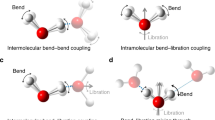Abstract
CONSIDERABLE attention is at present being focused on the effect of solvent environment on infra-red frequencies1–3. The early dielectric constant treatment of Kirkwood, Bauer and Magat4 (KBM), long known to be inadequate for the group frequencies which had been studied in any detail, namely, N—H (ref. 5) and C=O (ref. 6), has been followed by the dipolar association theory of Bellamy, Hallam and Williams1 (BHW). They have shown that the solvent shift of a range of X—H stretching frequencies (where X = boron, carbon, nitrogen, oxygen, sulphur, halogens) can be fully accounted for in terms of solute–solvent dipolar interactions and that the bulk dielectric constant of the medium plays an insignificant part. The same theory is also able to explain the major part of the shifts exhibited by X=O chromophores2. Other factors must, however, have some influence on these dipoles as the slopes of the BHW plots obtained on plotting the relative shifts against a common standard2 do not parallel other measures of bond polarity as would be predicted on the basis of the dipolar association theory and as has been demonstrated for X—H dipoles1, in particular, N—H (ref. 7). Buckingham's elegant extension of the dielectric theory has been tested and extended by Caldow and Thompson3 in their detailed evaluation of carbonyl and cyanide shifts. They suggest that both dielectric and specific interaction effects operate, and, by considering interaction terms, based on values of Taft's σ* inductive factors, conclude that the dielectric factor contributes about 30 per cent of the total Δν exhibited by C=O dipoles. Norrish9 has approached the problem via solute–solution interaction energies in terms of the internal latent heats of solute and solvent and the heat of mixing. However, as he points out, lack of data does not permit a rigorous test of his relationship.
This is a preview of subscription content, access via your institution
Access options
Subscribe to this journal
Receive 51 print issues and online access
$199.00 per year
only $3.90 per issue
Buy this article
- Purchase on Springer Link
- Instant access to full article PDF
Prices may be subject to local taxes which are calculated during checkout
Similar content being viewed by others
References
Bellamy, L. J., Hallam, H. E., and Williams, R. L., Trans. Farad. Soc., 54, 1120 (1958).
Bellamy, L. J., and Williams, R. L., Trans. Farad. Soc., 55, 14 (1959).
Caldow, G. L., and Thompson, H. W., Proc. Roy. Soc., A, 254, 1 (1960).
Kirkwood, J. G., in West, W., and Edwards, R. T., J. Chem. Phys., 5, 14 (1937).
Josien, M. L., and Fuson, N., J. Chem. Phys., 22, 1169 (1954).
Bayliss, N. S., Cole, A. R. H., and Little, L. H., Austral. J. Chem., 8, 26 (1955).
Cutmore, E. A., and Hallam, H. E., Conf. of European Molecular Spectroscopy, Bologna, September 1959, Spectrochimica Acta (in the press).
Buckingham, A. D., Proc. Roy. Soc., A, 248, 169 (1958).
Norrish, R. S., Nature, 187, 142 (1960).
Author information
Authors and Affiliations
Rights and permissions
About this article
Cite this article
HALLAM, H., RAY, T. Dielectric and Dipolar Interaction Theories of Solvent-induced Infra-red Frequency Shifts. Nature 189, 915–916 (1961). https://doi.org/10.1038/189915a0
Issue Date:
DOI: https://doi.org/10.1038/189915a0
This article is cited by
Comments
By submitting a comment you agree to abide by our Terms and Community Guidelines. If you find something abusive or that does not comply with our terms or guidelines please flag it as inappropriate.



